What does the “Biggest Loser” study tell us about the effects of massive weight loss?
If you’ve spent any amount of time reading diet & nutrition articles on the web and in magazines, then you have come across the words “slower metabolism” attached to many statements and claims. Given that we like to be analytical with our fitness here, we’re kicking off a series of journal clubs over time that will look at this topic of the slowing metabolism.
What better way to start this topic than with the “Biggest Loser” study that came out in 2012? A team of researchers, headed by a prolific researcher of all things weight, Dr. Hall, examined the participants of one season of the reality TV show, “The Biggest Loser”.
Methods
There were 16 participants studied: 7 males and 9 females. The participants went to “the Ranch” to live during the first part of the competition to lose the most weight. They lived there as long as they were not voted off the show, until 4 final participants went home after 13 weeks. Everyone continued their efforts at home until the season finale at 30 weeks. They all attended a live broadcast and had their final measurements taken then.
While at “the Ranch”, the participants worked out with cardio and resistance exercise 6 days/week. For 90 minutes each session, they were coached by the trainers. They were also encouraged to do up to 3 additional hours per day of exercises on their own. When they went home, they were encouraged to continue similar efforts.
They were all counseled to cut their calories by at least 30% every day. They were given individualized targets for calories.
At the start of the show, after 6 weeks, and at the end of the show, a number of measurements were taken. Aside from weight and height, they had blood tests, DEXA scans for body composition, resting metabolism (RMR) measured, and they had their total daily metabolism measured using Doubly Labeled Water (DLW). We’ve discussed the measurements of RMR and DLW before. This allowed the researchers to empirically measure the basic metabolism of the participants, the total calories they burned each day, and how many calories they burned from their activities.
Below are the starting descriptive stats for the participants. As always, they’re group averages and rounded to the nearest whole number for the ease of viewing.
Results
Below are the descriptive stats for the participants at 6 weeks and again at their final 30 weeks measurements.
@ 6 Weeks
@ 30 Weeks
After the first 6 weeks, the participants lost an average 10.3% of their weight. By 30 weeks, they had lost 37.9% of their weight. Of the weight lost, 82.6% was fat and 17.4% was lean mass (LBM). I say lean mass specifically because they lost a combination of tissues and a lot of water. After analyzing the composition data and citing research on the benefits of combining resistance exercise with weight loss (such as this), the researchers reported that they were confident most of the muscle tissue was preserved.
Dr. Hall also published a report in a 2013 that analyzed “The Biggest Loser” data with data of other studies on weight loss from exercise or diet only. His computational model reported that the same weight loss from diet only would have been comprised of 65% fat and 35% LBM. The same weight loss from exercise activity only would have been entirely from fat.
Below is the figure from the 2012 study that shows the measured metabolism results. I added the resting, activity, and total daily calorie numbers for clarity.
In his 2013 paper, Dr Hall reported that the participants ate an estimated 1300 calories/day during their time at “the Ranch” and an estimated 1900 calories/day while they were at home.
Using prediction equations made from studies of participants that were never obese and never lost weight, the researchers reported what the metabolism of the participants was expected to be. Below is a chart with the actual and the predicted resting metabolisms.
The predictions were higher by 244 calories at 6 weeks and 504 calories at 30 weeks. The participants that lost the most weight had the largest metabolic adaptation afterward, aka slowest metabolism. Their resting metabolism had the greatest drop. Hall’s 2013 model predicted that if the participants lost the same weight by dieting alone, then their resting metabolism would have been reduced by 25%. Had they lost the same weight using exercise alone, then their resting metabolism would have dropped by only 1%.
I’ve explained before how the technique that measures resting metabolism can also show how well we burn carbs and fats for energy. The researchers looked at that data and found the participants burned much more fat for energy than carbs both before and after weight loss. They did not have any problems metabolizing fat stores for energy.
Last, let’s review the blood test results. On average, the participants started out with some degree of insulin resistance. At the end of the study, they had improved their insulin sensitivity and their insulin/blood sugar results were normal. Their triglycerides improved by the end, also. Curiously, their cholesterol went up by the end. Their thyroid results were a mixed bag. On an individual level, they found that participants with improved or the smallest changes had the least amount of metabolic slowing. Those who had the worst changes in their thyroid markers had the greatest metabolic slowdown.
Thoughts & Implications
This study provides information about how physiology is affected by great amounts of weight loss. For those who have gone through such a large weight loss, this information is very informative about what they have experienced.
I was pleased that Hall, et al. addressed the 80/20 idea of weight loss. That is a common idea repeated in blogs and by exercise researchers. Exercise has a preservation effect for muscle when people lose weight. When the weight loss is below 10% of body weight, that preservation can produce results closer to 100% fat loss and 0% muscle loss. For weight loss over 10% of body weight, real world results tend to be closer to 80/20. Of course, many factors go into this, including how much body fat we start with when we cut weight.
The participants of this study burned 800 less calories everyday by the end than they did at the start. Given that they ran into the end of the competition still exercising, that 800 less calories was with a bunch of activity. If they stopped exercising so much, then their total daily metabolism would drop further. Of course, that is expected in the sense that a less active person burns less calories. However, in practical terms it means that they will have to adjust their eating if they want to continue to maintain their weight loss as less active people. This highlights the reality that the permanence of weight loss will, in part, depend on whether the changes made to lose weight are short or long-term. The return to patterns that resulted in the starting condition will ultimately mean regressing back. Lasting lifestyle changes are essential to maintain weight loss, composition changes, and/or health and wellness.
Plain & Simply
People who have lost more than 10% of their body weight, on average, have slower metabolisms than people of the same weight who never lost weight. It’s not a comforting result, but it is the truth of the matter. Fortunately, the researchers pointed to a multitude of results and the statistics provide information about the distribution of the metabolisms. Not everyone’s metabolism dropped by the end. Different people have different metabolic and hormonal responses to weight loss. Some are fortunate enough to have robust physiology in the face of massive weight loss. For those who face a lower resting metabolism, such as myself, we can still thrive. Just as we are not all monetary millionaires, so too are we not all metabolic millionaires. Such a long-term journey is certainly a different beast entirely, but do not fear. If we’re capable of losing a large amount of weight, then we are fully capable of thriving in a new lifestyle that includes a lower metabolism.
If you have any questions about this study or anything I said, please feel free to leave a comment. I will get back to you and others may have insight to offer, too. If you have any questions or topic suggestions that you would like answered as a post, then please email me at robert@analyticfitness.com.
Don’t forget to like Analytic Fitness on Facebook, or follow me on Twitter or the other social medias!

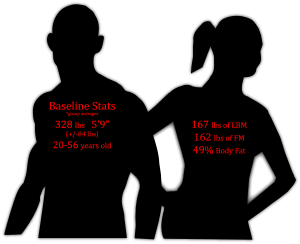
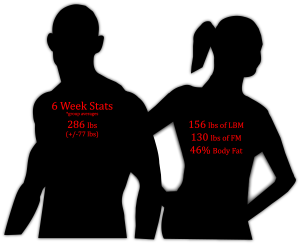
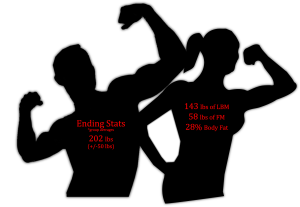
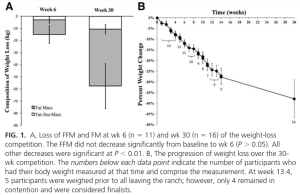
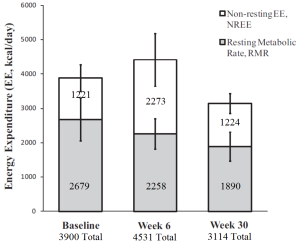
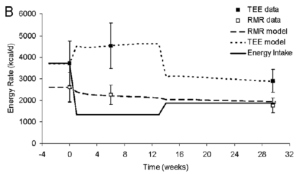





No Responses